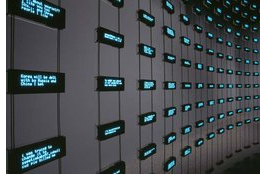Inspired by Science Fiction and Artistic Flow
 “In a moment of elated ‘ah-hah!’ while reading Isaac Asimov’s Foundation Series in 2002, I realized that much of what Asimov was predicting as possible with super computers did not require 12,000 but just 60 years computation evolution from 1951 to achieve an interconnected model of our world.
“In a moment of elated ‘ah-hah!’ while reading Isaac Asimov’s Foundation Series in 2002, I realized that much of what Asimov was predicting as possible with super computers did not require 12,000 but just 60 years computation evolution from 1951 to achieve an interconnected model of our world.
The Foundation stories are built upon an important planet at the center of the galactic Empire. In this distant, future place people continue to live in relative isolation, that is, their cultural identities well defined within an almost entirely concrete and steel world. I struggled for a few years with what this meant to me, against the backdrop of our own growing, global economy and seemingly malignant spread of pain and fear as resources dry up and borders find taller, more heavily armed walls.
In the summer of 2007 I was in San Jose and San Francisco three times in less than six weeks for trade shows for Terra Soft, one of which was just around the corner from the San Jose Museum of Modern Art. Tired of the show floor sales hussle, I visited an exhibit called “Listening Post” (below). It took my breath away when I realized I was experiencing not pre-recorded but live data streamed from ten thousand humans communicating in that very moment over the internet. It was painted before me in a concave array of small screens coupled with a voice synthesizer reading the contextual messages.
To be immersed in the realtime flow of the most basic of human expressions “I am …” without borders, without fear, was unforgettable. That experience stayed with me for more than a year when in December of 2008 I engaged my former business partner Dan Burcaw, founder of Double Encore (whose team would later build the iConji iPhone app), at a pub in Denver. I shared a concept for how a new kind of digital communication could bridge the gaps between the cultures of our world, not to take away their unique identities, but to express them.
A few more meetings, a few more beers, and iConji was born.” —Kai Staats, May 2010
Listening Post
 by Mark Hansen and Ben Rubin
by Mark Hansen and Ben Rubin
San Jose Museum of Art
Saturday, June 3, 2006 through Sunday, May 20, 2007
Listening Post analyzes all the text—typed just moments ago—by tens of thousands of people in Internet chat rooms around the world. It presents them as six different “movements,” combining musical tones, sound effects, synthesized voice, and scrolling text. For example, in the first movement, Listening Post monitors and displays a randomly typed text beginning with “I am.” It then searches the Internet for related phrases, creating a simultaneously funny, sad, nonsensical, pathetic, yearning, quotidian, and ultimately mesmerizing tonal poem of identity in the Internet age.
For centuries, the soaring buttresses, vaulted ceilings, and luminous stained glass of cathedrals, along with hymns and chants, have transmitted that which is beyond expression. Using algorithms, software, 146 x 233 x 31 inches, and data mining, Listening Post generates a similar experience around what sometimes seems beyond comprehension. Hansen and Rubin’s art facilitates a human-level connection to the immeasurable scale, vast content, and nano-immediacy of our communications universe.
